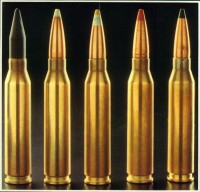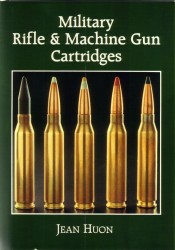Firearms Technical Trivia, September 1999:
 |
 |
 |
Frequently, it is not the best arms or munitions that survive the tortuous development and procurement process to be issued to a nation's front line soldiery, but those that have the strongest supporters and the most influential backers. Such was the case with the rifle cartridge foisted upon NATO in late 1953, and then rapidly abandoned by the United States; specifically, the 7.62mm NATO. While the rest of the world forged ahead with the development and perfection of the intermediate cartridge and the true assault rifles that would use it, the United States successfully managed to achieve a 12mm reduction in rifle cartridge case length with no significant savings in ammunition weight or portability, no significant enhancement in accuracy or controlability under full automatic fire, and no terminal ballistic improvements over the technology of 1906 of which to speak.
There were many cartridges developed in the heady years following the Second World War that would have filled the bill for a Western (non-Warsaw Pact - they had the 7.62x39mm!) assault rifle cartridge. A few of them are discussed below:
7.92x33mm
| This is the cartridge that began the assault rifle era. It was specifically designed to furnish the infantryman with a reduced power cartridge which would enable accurate full automatic fire at realistic combat ranges of up to 700 meters (compared with the 2,000 meters of the contemporary battle rifle cartridge). The 7.92mm Kurz, as it came to be known, was developed by the German firm of Polte in Magdeburg in 1938. The original load was a seven gram bullet propelled at 685 meters per second muzzle velocity. So successful was this round the the original prototypes of the famous FAL rifle were chambered for it! |
.270
(7x47.5mm)
 |
This was the less successful of the two cartridges proposed by the British Armament Design Establishment's (ADE) Ideal Calibre Panel as the "cartridge of the future" which would replace the .303, and carry Britain to the end of the century. The .270 was designed for a spitzer bullet of between 100 and 102 grains in weight, with a muzzle velocity of 2,730 feet per second. The round was submitted for consideration in June 1947, and withdrawn in April 1948. |
.280
(7x43mm)
 |
The more successful of the two cartridges proposed by the Ideal Calibre Panel. The .280 was originally designed, in January 1947 to fire a 130 grain bullet at between 2,330 and 2,450 feet per second. This was later amended in November 1948 to a 140 grain bullet at 2,415 feet per second. |
.280/30
(7x43mm)
 |
In April 1949, the ADE re-engineered the .280 so that it would offer the same base dimensions as the US T65 cartridge (the T65 was destined to become the 7.62mm NATO). Initially, the .280/30 offered the same ballistics as the .280, a 140 grain bullet at 2,415 fps, but this was increased to 2,595 fps in late 1950. Eventually, the .280/30 was sealed as "Cartridge 7mm Ball Mk. 1Z" in August 1951. It was this round for which the initial production versions of the FAL were designed. It was also the last indigenously designed cartridge fielded by the United Kingdom. |
7mm
High Velocity (7x49mm)
 |
In late 1951, in response to American criticisms that the .280/30 was simply not powerful enough, the ADE, working closely with Fabrique Nationale (FN), developed the 7mm HV. This was done by lengthening the .280/30's case from 43mm to 49mm, and increasing the 140 grain bullet's muzzle velocity to 2,670 feet per second. |
7mm
Compromise (7x51mm)
 |
Concurrently with the development of the 7mm High velocity, the ADE began a joint venture with the Canadians in an effort to meet the American ordnance establishment more than halfway. These efforts led to the 7mm Compromise, which was nothing more than the 7.62mm NATO necked down to 7mm and firing the .280/30's 140 grain bullet at a muzzle velocity of 2,800 feet per second. If anything would make the Americans see the sense inherent in the 7mm concept, this was it. It didn't. |
7mm
2nd Optimum (7x49.15mm)
 |
This cartridge was developed in parallel with the 7mm Compromise in late 1952, and was the work of a joint Canadian, UK, and Belgian team. This round launched the 140 grain bullet at 2,775 feet per second. While the round was unsuccessful in the competition with the 7.62mm NATO, it was further developed by FN, and enjoyed a degree of success in South America, where it was known as the 7mm Liviano, and was used in the FAL rifles bought by Venezuela. |
7.92
x 40mm
| This round was developed at the Spanish Centro de Estudios Tecnicos y Materiales Especiales (CETME) for the CETME assault rifle in 1950. It was a development of the German 7.92x33mm round. It fired a 7.5 gram bullet with an aluminum core at a muzzle velocity of 800 meters per second. |
7.62
x 40mm
| This was a necked down 7.92x40mm. It was designed by CETME's Dr. Voss, and developed at the National Munitions Factory at Palencia, Spain in 1953. It fired a 7 gram bullet at 800 meters per second. The projectile was unique in that it had an extremely long aluminum cored bullet with a gilding metal jacket and an exposed aluminum tip. |
7.62
x 51mm CETME
 |
This cartridge was designed by Dr. Voss at CETME for the CETME Model 58 assault rifle in 1957. While dimensionally identical to the 7.62mm NATO, it fired a lighter bullet (7.25 gram versus 9.45 grams) at a reduced velocity of 760 meters per second. The reduced power of this round vice the 7.62mm NATO made aimed fully automatic fire possible with the CETME Model 1958. |
7.5
x 38mm
 |
The British and the Spanish were not the only ones to take note of German small arms developments at the end of the Second World War. The Swiss developed the 7.5x38mm round in 1952 pursuant to their assault rifle research. The 7.5x38mm fired an 8.5 gram bullet at 740 meters per second. |
7.5
x 43mm
 |
The 7.5x43mm was an assault rifle cartridge developed in France in 1949, using an 8.2 gram bullet. |
Note: Data for this month's trivia page was gathered from:
Gotz, Hans Dieter, German Military Rifles and Machine Pistols, 1871-1945, Schiffer Publishing, Ltd. (West Chester, Pennsylvania, 1990) ISBN 0-88740-264-X
Huon, Jean, Military Rifle and Machine Gun Cartridges, Ironside International, Inc. (Alexandria, Virginia, 1988) ISBN 0-935554-05-X
Molina
Lopez, Angel and Alfonso Orea Maestro, Cartucheria Espanola,
V. Merino, S.L. (Palencia, Spain) ISBN
84-604-3013-8
Stevens, R. Blake, The FAL Rifle, Collector Grade Publications (Toronto, 1993) ISBN 0-88935-168-6
The FAL Rifle is available from IDSA Books.
Cartucheria Espanola can be purchased by writing to V.Merino, S.L., Apartado 101, 34080 Palencia, Spain, and inquiring as to price and availability.
Military
Rifle and Machine Gun Cartridges is available from Amazon.com.
Click on the image to order:

German
Military Rifles and Machine Pistols, 1871 - 1945 is available from
Amazon.com. Click on the image to order:

|
|